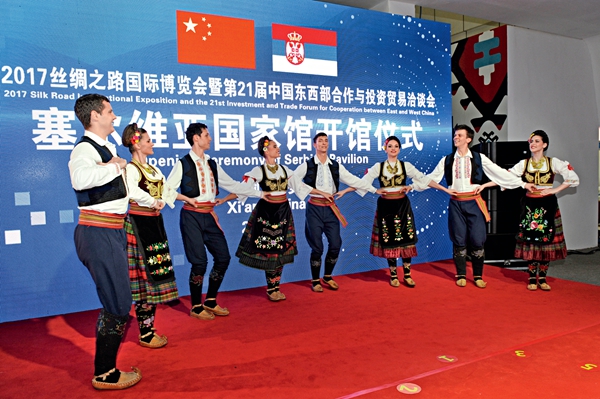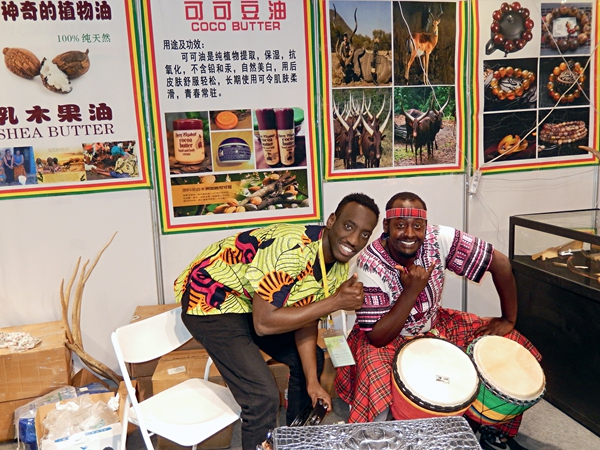On the Road Towards Further Openness
By staff reporter ZHOU LIN
FOUR years ago, Chinese President Xi Jinping delivered a speech at Kazakhstan’s Nazarbayev University, to express his hopes for the Silk Road Economic Belt. He emphasized an innovative and collaborative approach to deepen cooperation and expand the scope of development in the Eurasian region.
The initiative is seen as a monumental undertaking that will greatly improve the lives of hundreds of millions of citizens in the countries along the routes. The initiative calls for beginning in specific areas and then linking them up over time. To that end, coordinated policies, improved infrastructure, unrestrained trade, financial integration and better understanding between peoples are vital.

As Hu Angang, director of the Institute for Contemporary China Studies at Tsinghua University, remarked, the Belt and Road Initiative signifies that China is taking its open-door policy to a global scale and catalyzing an unprecedented revolution in economic geography in human history.
Serbia’s Trade with China
Shaanxi Province in central China is the starting point of the ancient Silk Road and is also regarded as the new beginning and focal area of the Silk Road Economic Belt. Every year, the province hosts the Silk Road International Exposition (SRIE) and Investment and Trade Forum for Cooperation between East and West China (ITFCEW) in its capital city Xi’an, aiming to establish it as a transport and trading center linking eastern and western parts of China and the countries along the Silk Road.
By fully integrating the Belt and Road Initiative, the province expects to make it a hub of international capacity cooperation, a scientific and educational base to foster innovation, a cultural and tourism center and a regional financial center as well. Shaanxi hopes to play a part in enhancing the level of opening-up of central and western China, and accelerating constructive cooperation with nations along the Belt and Road.

Located in the southeast of Xi’an, Qujiang New Area focuses on the development of the culture and tourism industries. The 1,300-year-old Great Wild Goose Pagoda, landmark of Xi’an, is situated there. Buddhist scripture scrolls taken from ancient India by eminent monk Xuanzang are preserved inside. Now the new district is built with row upon row of modern, upscale housing societies and duty free shops stocking imported goods. Thus, an ancient metropolis has regained its stature imbued with modern comforts and facilities.
In June, SRIE 2017 was held in the Qujiang International Conference & Exhibition Center where 300-plus enterprises from over 42 countries and regions as diverse as Serbia, Pakistan, India, Thailand, Russia, South Korea, and Brazil participated. As the guest country of honor, Serbia set up the largest pavilion in the exhibition area, in which Serbian commodities were showcased, such as milk powder, honey, and wine. Serbian folk songs and dance performances also enthralled audiences.
“I hope to introduce and recommend Serbian commodities, high-tech products and services to China and to other fellow countries along the Silk Road,” said Nikola Paunovie, head of the Serbia Pavilion reception department. Serbia sent a big delegation comprising more than 100 members. At the pavilion staff members were busy with explaining trade policies and industrial programs to Chinese customers, and businessmen from different countries discussed opportunities for cooperation in the areas of logistics, agriculture, culture, film and entertainment.
Paunovie came to Xi’an for the second time and was fascinated by its culture. Based on his contact with Chinese enterprises, he discovered that although there was good potential for cooperation, it was hampered by lack of knowledge of Serbian policies and market dynamics. Therefore, he specially arranged for specialists to introduce their respective programs. Many interested visitors in Serbia Pavilion proved that it was a prudent idea.
Chinese people born in the 1960s and 1970s are familiar with Serbian movie Valter Defends Sarajevo and its theme song. Director of the movie Emir Kusturica introduced the city of Kragujevac located in the hinterland of Europe with these words: “No place in the world can compete with home; no place can display the mystery and charm of Serbia; and no place owns the distinctive culture as the city of Kragujevac.” The message resonated strongly in both Chinese and Serbian people’s hearts and encouraged the city of Kragujevac to join hands with China to build a film and television cultural base to attract more Chinese and European tourists.
The City of Kragujevac is the 29th sister city of Xi’an, and the hometown of Serbia’s former president Tomislav Nikoli. The city councilor Igor Mitrovic attended the Expo and explained some details of programs in the fields of film and television, modern agriculture, industrial and amusement parks.
Meanwhile, Marija Labovi, CEO of National Tourism Organization of Serbia, told China Today, “Visa-free policy provides convenience for Chinese travelers and we sincerely hope that more visitors come to enjoy their vacations in Serbia. By the end of this year, Serbia’s capital city Belgrade and Beijing will have direct flights as well.”
On January 15, 2017, the bilateral Visa Free Agreement between the two countries came into force officially. By the end of April 2017, the number of Chinese tourists to Serbia had increased by 300 percent compared to the corresponding period last year. Statistics also show that, this number of Chinese visitors has maintained a strong double-digit growth over five consecutive years since 2012.
A Pakistani Businessman in China
Siddiq Memon is a Pakistan businessman attending the exhibition in Xi’an for the third time. He seems to be better informed about Chinese customers than his Serbian counterparts.
At stand A074 of the Silk Road International Pavilion, Siddiq Memon displayed ornate white jade decorations and copper ornaments with inlaid gold made in his hometown. These handmade household and office decors are not cheap: a pair of 30-cm-tall white jade vases costs approximately RMB 1,200; and the copper ornaments are more expensive as a couple of spotted deer of the same size cost up to RMB 1,800. “Each of these copper exhibits has been exquisitely carved, polished, lacquered or stove varnished by local handicraftsmen,” Siddiq Memon said.
Siddiq Memon, 36, comes from Karachi, Pakistan’s largest and most populous city. “The market here is so big that earnings grow year after year. Now the sales revenue in China accounts for 70 percent of my entire sales a year!” He further explained that the other 30 percent came from Pakistan, India and Turkey combined.
To save human resources, Siddiq Memon brought with him his younger brother and an assistant to Xi’an this time. All commodities were parceled and transported over the maritime route to China, taking almost one month. China’s southern port city Guangzhou and northern port Tianjin were two places Siddiq Memon chose to offload the goods which were then transported by land to Xi’an.
Over the last three years, Siddiq Memon has traveled to many Chinese cities, among which Yiwu of Zhejiang Province left with him a deep impression, as it’s the world’s best-known small commodities wholesale market. “Yiwu is a good place to do business, get acquainted with friends, and collect useful information.”
Besides, Siddiq Memon likes Guangzhou and Xi’an, two cosmopolises with lots of Muslims who hold the same religious belief as him. He joked, “Their foods are more adaptable to my stomach.”
Kunming in Yunnan Province is another good choice, where his goods are often sold out immediately. He has even been to Hainan Island, but soon discovered that tourists seldom take heavy decors from the island back home. When he was asked why not choosing metropolis like Beijing and Shanghai, he mischievously replied, “People there are always busy and have no time to walk around exhibitions or buy commodities.”
After three years’ experience, Siddiq Memon has a good understanding of the Chinese market and potential customers. “People in Inner Mongolia and Harbin like to buy our giant white jade decors and copper ornaments inlaid with gold, as they are willingly to splurge on luxurious decorations.” The growing middle class, which wields immense purchasing power, has been seized by this prudent Pakistani businessman as a target market.
During the interview, Siddiq Memon made another sale, selling a pair of white jade vases to a Chinese buyer who tried bargaining for a lower price. Tactful Siddiq Memon gave him a small jade plate gratis and successfully sold the vases at the original price. He seems to have the ability of figuring out every buyer’s purchasing psychology and understands that customers are asking for a more satisfying retail experience rather than bargaining for a cheaper price.
“This year’s sales data have not been calculated yet but I hope it will be a satisfying result.” Siddiq Memon scanned the reporter’s WeChat on his cellphone, saying, “The Chinese are so smart to invent WeChat payment which helps me sell goods and receive money far away in Pakistan.”
Opening up to the World
From the farthest Eurasian countries bordering Europe right up to the Central Asian nations on China’s western borders, the manifestation of the Belt and Road Initiative from bold, ambitious proposal to concrete, game-changing reality is for all to witness. In fact, the tangible results and success have spurred other countries to also express the desire to be part of this titanic undertaking. The attitude of collaboration and mutual development makes it more than the sum of its parts such as China’s strategic initiative or an economic endeavor but a truly humanitarian and global undertaking based on mutual benefit and growth. Its credibility is also bolstered by China’s phenomenal economic success and mind boggling transformation over the last three decades.
The Belt and Road Initiative also expounds on the notion of the Chinese strategy of opening up to the world in the hope of creating a more open and inclusive future with other nations, in order to create a brighter future for all. On the one hand, since China’s reform and opening-up in 1978, foreign capital, technologies, management expertise and talents have all flowed into China as essential productive contributors. On the other hand, the Belt and Road Initiative focuses on the interconnection of infrastructure, integration of policies and regulations, and more people-to-people communication, thereby facilitating exchanges of essential productive factors among countries along the Belt and Road.
Spanning from the Asia-Pacific Economic Circle to the European Economic Area, most countries along the Belt and Road are developing economies. They are facing similar problems that China encountered and overcame at the early stages of opening up. The same conditions become a realistic base for win-win cooperation and mutual development. Therefore, China focuses on the establishment of an inclusive and open platform to carry out regional cooperation on a wider range and higher level.
Furthermore, the transformation also brings opportunities for China to build a more open and diversified economy. Along with products being exported globally, China is opening its door to emerging economies rather than just the developed countries, and the regional cooperation platform plays a crucial role in the global market.
Thus, China’s policy of openness is both revamped and reenergized by the Belt and Road Initiative, facilitating national rejuvenation in the mode of the new normal of economic development while simultaneously sharing invaluable development wisdom with developing countries and regions along the Belt and Road.
